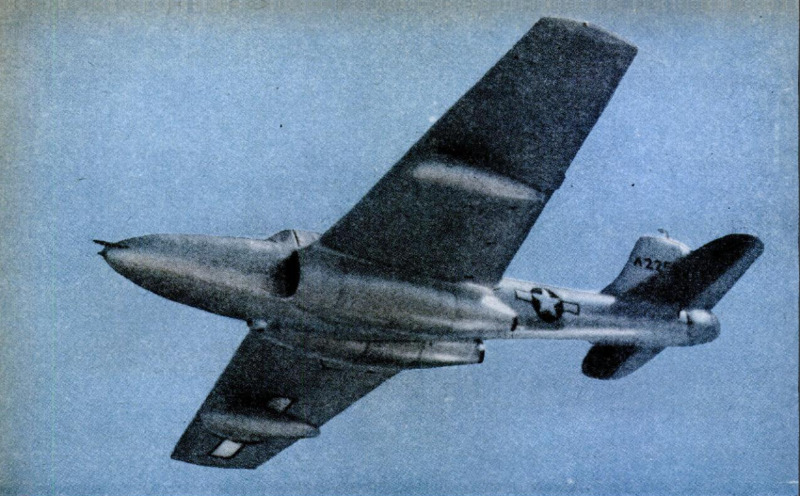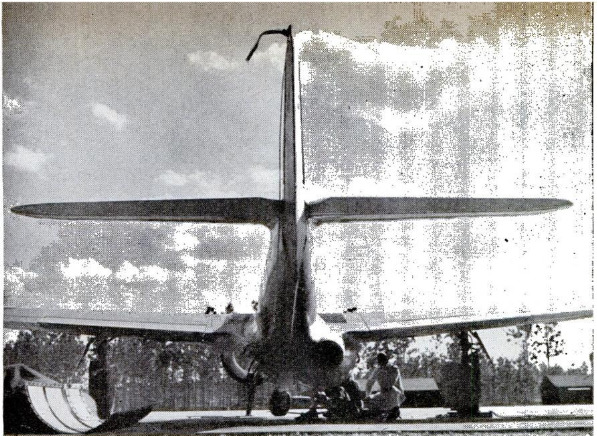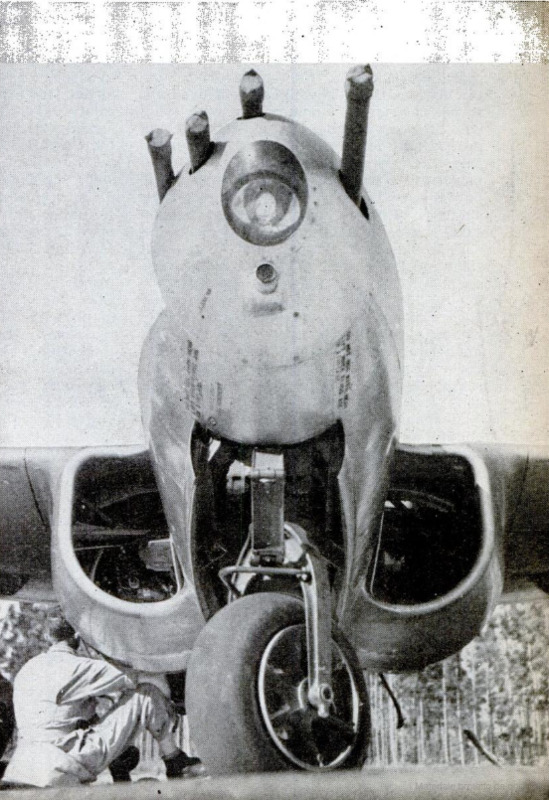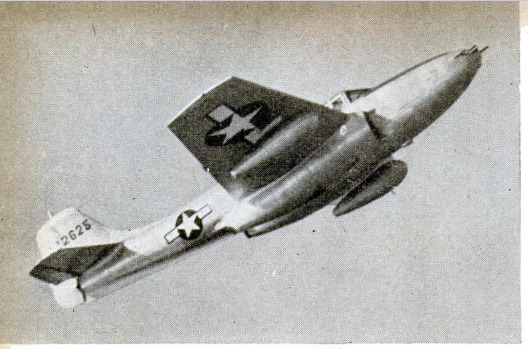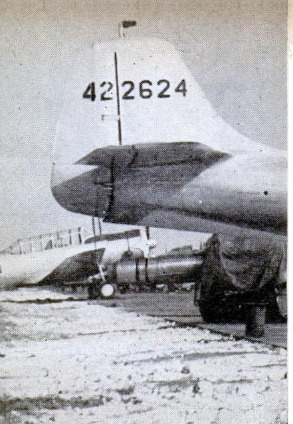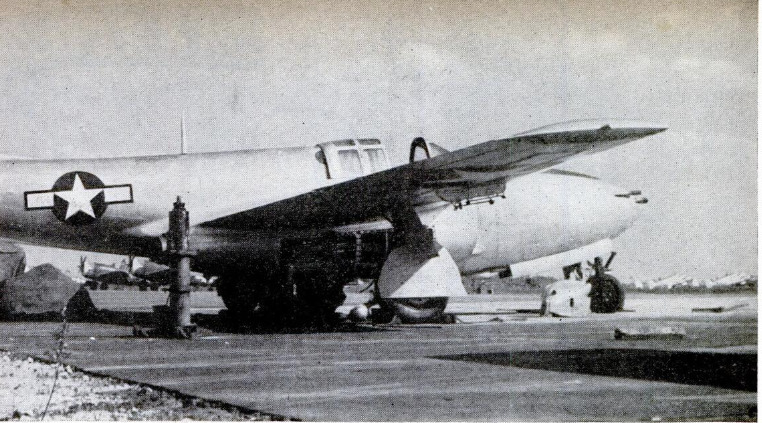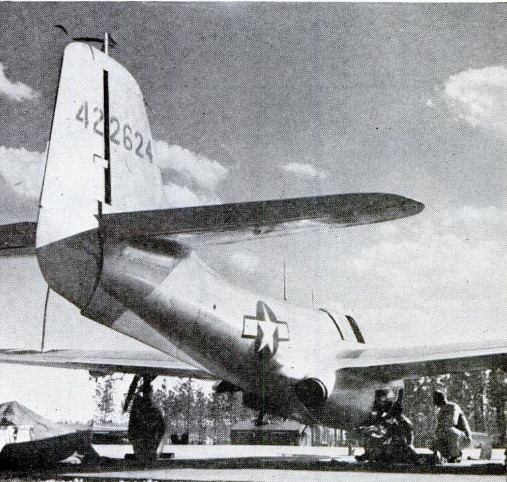-
Title (Dublin Core)
-
They learn about jets from her
-
Article Title and/or Image Caption (Dublin Core)
-
They learn about jets from her
-
extracted text (Extract Text)
-
AMERICAN jet-fighter pilots, who soon
will be taking the new P-80 Shooting
Star into action, learned their stuff in the
P-50 Airacomet, the Army's twin-engine
jet fighter-trainer. For months tests have
been run, tactics developed, and pilots
checked out on the P-59. It has been the
primary test ship for our present jet pro-
gram, and lessons are still being learned
from it, both on the ground and in the air.
On the ground, it's not a particularly im-
pressive plane. Unusual, yes, for it looks a
bit like a Kingeobras fuselage with mid
wings and no prop and unusually stubby
landing gear. Seen from the front, it seems
to goggle at you from two vacant, close-set
eyes, the intake ports for the engine nacelles,
which are faired into the fuselage just un-
der the wings. In side view, it has a sway-
back appearance, for its tail rides high to
clear the blast from the engines.
Then the starters whirr and the engines
spit flame, a few seconds of orange fire that
roars away into a shimmer of blue heat.
Dust whips up 75 or 100 feet back of the
plane. Brakes are released and the ship
lumbers away, turns awkwardly down the
runway. She quickly gathers speed, lifts,
and is airborne. Up she goes, at an aston-
ishing angle of climb. Suddenly you realize
that there goes the jet ship, an airplane
without a propeller, without a piston, with-
out anything like the engine you always
considered necessary to take a plane into
the air and Keep it there. This ship has
“squirted” itself into the air with a couple
of outsize oil stoves and a pair of whistling
fans. Tn fact, its most noticeable noise is
the tinny whistle you associate with the
sudden acceleration of a big electric fan.
And when it really gets going you don't
hear even that sound until the ship is past
you. Then you hear that strange rumbling
Toar peculiar to the jet ships, the growl of
violently disturbed air that sounds like a
freight train between two high hills.
The ship climbs swiftly, levels off, gathers
speed. The pilot puts it through maneuvers,
Just to show you its paces.
No doubt about it, the
Airacomet handles with
remarkable ease at con-
ventional speeds. Then he
goes on up, where the air
starts to thin out, and he
begins to open her up. She
looks like a gnat up there,
a silvery. gnat in a great
hurry. She streaks for the
far horizon, and you real-
ize that the talk about jet-
plane speed is more than
talk.
Then she comes back, in
a wide sweep over the
field, losing altitude very
slowly. One sweep, and
another, and still she is
gliding in; and then she
comes leisurely down
toward the runway, kill-
ing speed, dropping n al-
most like a glider. Down,
down—still with a lot of
lift, although she seems to
be coming in no faster
than a Cub plane. Then
she is in. She sort of
hunches down, sets her
wheels on the ground,
quivers a little, and rolls
down the runway to a stop.
Technically speaking,
the P-59 is a mid-wing
‘monoplane with a span about three feet less
than that of a P-38. As it comes off the as-
sembly line, the P-59 weighs about five tons.
It has a tricycle landing gear with wing
wheels exceptionally far apart. Landing
gear is fully retractable. It is a single-place
ship with conventional-type controls. Horse-
power of its twin jet engines Is undisclosed,
but the somewhat larger engine in the
single-jet P-80 is said to develop around
4,000 horsepower. Top speed also is undis-
closed, but both German and British jet
ships are known to be able to top 500 miles
an hour. Officially, the P-59 has “over 400
mph” Its speed and efficiency increase
with altitude, and its ceiling is officially
listed as over 40,000 feet. Pilot's compart-
ment is pressurized, but the pilot uses oxy-
gen even at the usual levels for the simple
reason that the oxygen in the cabin's air is
s00n exhausted.
Mechanics fall in love with the ship. The
engines are unbelievably simple, having only
two moving parts, the impeller or com-
pressor, and the turbine which drives it,
both attached to the same shaft. All told,
the jet engine has only about one tenth as
many parts as the conventional reciprocat-
ing engine. A whole engine can be removed
from the P-50 in just a bit over half an
hour, and the mechs say they can remove
and replace both engines in a short day.
Further, they don't need a mech stand to
work on these engines. Actually, they use a
garage mechanic's “creeper” for a good
deal of the work, because the engines are
50 low the mechanics work flat on their
backs a good deal of the time,
The jet engines will operate on almost
any inflammable hydrocarbon, but kerosene
has been used and found most satisactory
in most of the test and tactical work done
at the Air Forces Tactical Center in Florida.
Pilots and engineers say, however, that they
can run the ship on anything from hair
tonic to brandy.
Pilots have many kind words for this
ship. “It handles as easy as a glider,” one
pilot says—adding, “at average speeds.”
Actually, at the speed of a conventional
plane it ‘seems to handle with exceptional
ease, and the boys say it takes them back to
“stick-and-rudder days.” Complete lack of
torque contributes to its easy performance.
Other factors are low wing loading and lack
of propeller drag. It has such a flat glide
that some of the pilots will tell you it coasts
three times as far as the ordinary pursuit
ship. This is evident when you watch the
ship land; it has to stall around and kill
speed for an unusual time before it settles
down. Most pilots overshoot their mark the
first few times they try to land it. This is
also caused, in part, by the short landing-
gear struts. The jet plane sits much closer
to the ground than propeller-type ships.
The P-59 has unusually good stall char
acteristics. Pilots say it gives ample warn-
ing, shuddering, then falling off straight
ahead without yawing into a spin. “When
you want to spin,” says ome pilot, ‘she
handles like a baby buggy. I've turned out
of a five-turn spin in three quarters of a
turn. On accelerated turns, though, you've
got to watch your step. When you're hitting
400 mph. you reach four G's (four times
gravity's pull) in a hell of a hurry. Just a
few seconds of that and you black out, un-
less you've got a G suit to protect you.”
There is virtually no engine vibration in
a jet plane. About the only moise is the
swish and roar of air on its wings, with the
background rumble of the jet engines’ pow-
er exhaust. Lack of vibration greatly les-
sens pilot fatigue and improves pilot ef-
ficiency and reaction. Again, the pilots liken
the feeling to glider flying. At conventional
speeds, that is, above 400 miles an hour, it's
something else again. This lack of vibration
raised an unusual instrument problem in
the P-50. The pilots
had to put “rattlers”
on the instruments to
make sure they were
working; they didn’t
trust them without the
usual vibration rattle.
The P-59 is a twin-
jet job, but she can fly
and land on one jet.
“And she has plenty
of speed on one,” the
pilots assure you. Be-
cause the two jets are
snuggled close to the
fuselage instead of
out on the wings, the
failure or cutout of
one jet does not great-
ly alter the flying
characteristics of the
ship.
Those who see the jet ship for the first
time often wonder about the suction of the
engine intakes and the blast from the jet
nozzles. There is a strong suction at the |
intake, and in the air it might conceivably
gobble up a few birds. To prevent this, pro-
tective screens are used. The nozzle blast
is dangerous—as dangerous as the arc of a
whirling propeller. Anyone walking into |
that blast 20 feet
from the ship probably would feel as
though he had walked into the path of a
flame thrower. Fifty feet away he might be
knocked from his feet, but he wouldn't get
badly burned.
Principal problem of today’s jet planes
has been fuel consumption—lack of range.
Jet engines have been far from economical
on take-off or at low speed and altitude.
Only at high altitude and speed have they
been as economical as conventional airplane
engines. The Germans also have had to
face this problem, which has limited opera-
tional range. But our engineers seem to be
well on their way to a solution; official an-
nouncement of the P-80 says that it “op-
erates over any of the ranges at which
conventional pursuit ships of today are
called upon to perform.”
Among the pilots who checked out on the
P-50 were boys who, flying our conventional
fighters, had faced German jet planes over
Europe. How does the P-59 compare with
the German jet jobs? “I couldn't say,” one
such pilot replies with a smile. “I never
flew one of the German jobs. And they
never stuck around long enough for us to
study them.” In combat, the German fet
planes usually operate at extreme speeds,
‘making perhaps one or two passes at a con-
ventional fighter and then getting away
from there in a hurry. At such speeds, our
pilots generally agree, the German jets are
slow in maneuver, and a conventional Amer-
ican fighter plane can side-step them unless
the pilot is caught completely by surprise.
The German jets traveling 500 m.p.h. or
better seem to need about five miles to turn
around. Our conventional fighters can turn
in about a mile at around 400 m.p.h.
‘The pilots do indicate, however, that the
P-50 at the speed of a conventional fighter
—that is, around 400 m.p.h.—probably can
outmaneuver the best of the German or Jap
conventional fighters. In addition, it has at
least the extreme speed of the German jet
Jobs, with consequent loss of maneuver-
ability.
The future of the fet plane is anybody's
guess. You hear all kinds of predictions.
Lawrence D. Bell, president of the Bell
Aircraft Corp, which built the Airacomet,
says: “Within five years no military fighter
planes will be built which do not incorporate
the jet-propulsion principle. There is no
doubt that jet-powered planes will make
all present types obsolete in years to
come.” That opinion is not universal, even
among those who have worked a good deal
with the jets. But there is no doubt that
the jet plane is already opening a new
horizon in flying.
Right now one can sum up the advan-
tages of the jet plane in this way:
It has more speed and a higher ceiling
than the conventionally powered ship.
It has less weight per horsepower at alti-
tudes of equal operating efficiency.
It has considerably fewer working parts,
which means less danger of breakdown; it
also means simplified maintenance.
A practical pilot, with plenty of hours
over enemy territory and a respectable
number of enemy kills to his credit, sums
it up this way:
“The fet is fast as all hell. It can out-
climb anything else I've ever seen. It can
outmaneuver most of them at their own
speeds. It would be a honey for strafing, or
for attacking bombers, or probably for dog-
fighting, though today you usually make a
couple Of swift passes and get him or get
the hell out. It's a thoroughly sweet ship.
But T'd like to know what happens to her
when she takes a piece of flak or a few
50's through those windmill furnaces of
hers. Maybe I'm jittery, but I know how
the ships I've been flying over there—the
propeller ships—act when that happens. 1
know how much they'll take and still bring
me back. When I know as much about the
Jet jobs, then I can speak with authority.
Meanwhile, she's one sweet ship to fly.
Ain't had so much fun since I was a kid in
high school.”
-
Contributor (Dublin Core)
-
Hal Borland (article writer)
-
Language (Dublin Core)
-
eng
-
Date Issued (Dublin Core)
-
1945-06
-
pages (Bibliographic Ontology)
-
82-85,212, 216
-
Rights (Dublin Core)
-
Public domain
-
Archived by (Dublin Core)
-
Sami Akbiyik
-
Marco Bortolami (editor)
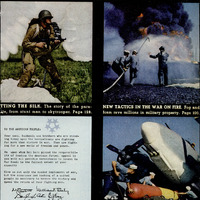 Popular Science Monthly, v. 146, n. 6, 1945
Popular Science Monthly, v. 146, n. 6, 1945

